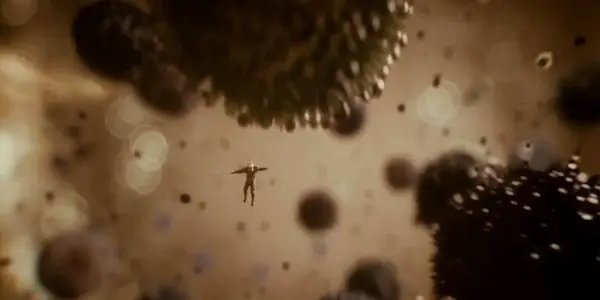Fantasy Science Pt. 9: Going Subatomic In ANT-MAN

Radha has a PhD in theoretical quantum physics. Apart from…
Subatomic particles. Quantum physics. The uncertainty principle. Have you heard terms like these flying around the science fiction sections of the film world? Have you ever wondered just how accurately these films portray real science? Well, my friends, today is your lucky day: this column, Fantasy Science & Coffee, aims to bridge the gap between science and science fiction in films and, occasionally, popular culture. My hope is to explain things in a fun way – like we’re chatting over coffee.
You may be thinking: who is this person, why does she think she can explain science, and why the heck would I want to have coffee with her? Well, I’m Radha, a researcher in India, currently pursuing a PhD in theoretical quantum physics. I quite like hot beverages. I’ll also pay.

In this eighth part of the series published on the second and fourth Tuesdays of every month, we are going to look at what the Ant-Man films call “going subatomic”. Let’s begin.
Resizing Ant-Man
The Marvel superhero, Ant-Man, wears a suit that can make him incredibly small or incredibly large at will by using Pym particles created by scientist Hank Pym. They’re described by Darren Cross of Futures Lab at the beginning of the first film, released in 2015:
“…a particle that could change the distance between atoms, while increasing density and strength.”
This is a fairly interesting concept, and I believe that not only is he talking about the distance between atoms, but the distance between the nucleus of the atom and its boundary as well, since atoms themselves are largely made up of empty space.
Take a look at this Ted Ed video:
It describes a useful analogy when trying to visualize just how astonishingly empty an atom really is: if an atom was the size of, say, a football stadium, the nucleus would be just about the size of a marble! It is therefore plausible in a science fiction context that this space could be reduced as a means to shrink a person.
If you dive deeper and look at this mechanism closely in terms of real science, a few plausibility issues arise. For instance: if Scott Lang, aka Ant-Man, retains his mass when he shrinks, then the tank carried around by Pym on a keychain would as well. That’d make for one impossibly heavy keychain. If, on the other hand, Lang doesn’t retain his mass, then he wouldn’t be very strong when it comes to blows. If part of his mass is converted to energy a la Einstein’s famous E=mc^2 equation, there’d likely be a sort of explosion every time the transformation happens. The list goes on. Rhett Allain, Associate Professor of Physics at Southeastern Louisiana University, mulls over these issues and explores how extra dimensions may theoretically be used to store excess mass in an interesting Wired article.
However, the purpose of our chat here is not to contemplate how Ant-Man’s resizing technology works, but to look at an interesting concept introduced in the first Ant-Man film: what “going subatomic” means in the Marvel Cinematic Universe.
Going Subatomic: Ant-Man vs. Real Lif
The term first came to light when Lang decides to ‘fix’ the regulator on his suit that controls the resizing function:
Hank Pym: Do not screw with the regulator. If that regulator is compromised you would go subatomic.
Scott Lang: What does that mean?
Hank Pym: It means that you would enter a quantum realm.
Scott Lang: What does that mean?
Hank Pym: It means that you would enter a reality where all concepts of time and space become irrelevant as you shrink for all eternity. Everything that you know, and love, gone forever.
Perhaps the use of the word ‘reality’ is a stretch, and we know from both Ant-Man films that shrinking for all eternity does not happen upon entering the quantum realm, but the crux is absolutely valid in real life: events at a subatomic level are truly bizarre and the laws of physics differ greatly from what we experience in our daily lives. At a subatomic level, quantum physics comes into play, which is governed by probabilities.
You see, we live in a macroscopic world, governed by classical physics. If you toss a ball to a playful dog, you and the dog can both easily predict with certainty where the ball would land, based on its trajectory and how hard you throw it. ‘Tossing’ an electron would be completely different, because of the uncertainty principle: one cannot simultaneously predict where the electron is and how fast it’s moving. An analogy of the uncertainty principle can be made by trying to find the position of a soccer ball in a field by randomly throwing tennis balls around the field. If a tennis ball strikes something, you’d know where the soccer ball is, but by striking the soccer ball you’ve set it into motion and do not know how fast it is moving. Thus both the position and the momentum of the soccer ball cannot be known simultaneously.
To your eye, the trajectory of the electron would be bizarre. You would only be able to predict where it is likely to land, based on probabilities. It’s probably a good thing we don’t encounter quantum effects on a macroscopic scale. My favorite illustration of just what the world may look like if we experienced quantum physics on a macroscopic level is in Brian Greene’s documentary series The Elegant Universe:
Greene describes a hypothetical visit to the ‘Quantum Cafe’, a cafe governed by quantum physics, and thus, probabilities. Even if you place a specific order, chances are that you would get something you didn’t order. “I’ll try,” says the bartender when Greene asks for orange juice.
In the context of Ant-Man, if someone in the Marvel Cinematic Universe were to go subatomic, chances are that that someone would be trapped for a very, very long time, because the probability of escaping would be negligible. That’s exactly how Hank Pym lost his wife. She went subatomic to disable a bomb, and therefore became stuck in the quantum realm.
Spoilers ahead: The premise of the 2018 film Ant-Man and the Wasp is to rescue Pym’s wife, since Lang is unexpectedly successful in returning from the quantum realm.

Lang uses his daughter’s voice as an anchor to return to the macroscopic world. Let’s see how this could possibly happen in terms of real science.
Ignoring the fact that a person who accidentally went subatomic wouldn’t exactly have oxygen to breathe, I agree that if one were to shrink to a size smaller than an atom, it’d be terribly difficult to escape but not completely impossible: the probability would exist, it would just be slim. The way it is in an interesting phenomena called quantum tunneling.
It goes something like this: if a subatomic particle is trapped behind some barrier, with no means of escape (e.g., lacking the energy to penetrate the barrier) it may still appear beyond the barrier provided there’s even a slight probability of it appearing beyond the barrier. It sounds counterintuitive, but basically, if something called the wave function, which describes the state of the particle, extends beyond the barrier, then there’s a non-zero probability that the particle will ‘tunnel through’ the barrier. The joke in quantum physics goes: if you truly believe in quantum physics, and you lean against a wall for millions of years, at some point you may pass through it.
In Ant-Man, this slim probability is attributed to whether or not the person in the quantum realm has an anchor to latch onto. I believe that having this anchor increases the probability of escaping from negligible to slim. Lang has his daughter’s voice, and Pym’s wife has her entanglement with Lang to rely on for their respective escapes.
What do you think? Do you agree with me, or do you agree with the film’s depiction of “going subatomic”?
More to Explore
Articles
Wired: The Shrinking Building in Ant-Man and the Wasp Would Cause Massive Problems (2018)
Wired: Ant-Man Shrinks by Stretching into Other Dimensions(2015)
Documentaries
PBS/Nova: The Elegant Universe
Books
The Elegant Universe by Brian Greene
Concepts of Modern Physics by Arthur Beiser
Quantum Computation and Quantum Information by Michael A. Nielson and Isaac Chuang
Resources
Hyperphysics: The Uncertainty Principle
Hyperphysics: Tunneling
Marvel Cinematic Universe Wiki
Does content like this matter to you?
Become a Member and support film journalism. Unlock access to all of Film Inquiry`s great articles. Join a community of like-minded readers who are passionate about cinema - get access to our private members Network, give back to independent filmmakers, and more.
Radha has a PhD in theoretical quantum physics. Apart from research, she consults on sci-fi screenplays/books. In her free time, she cosplays and irritates her three cats. Bug her on Twitter: @RadhaPyari













